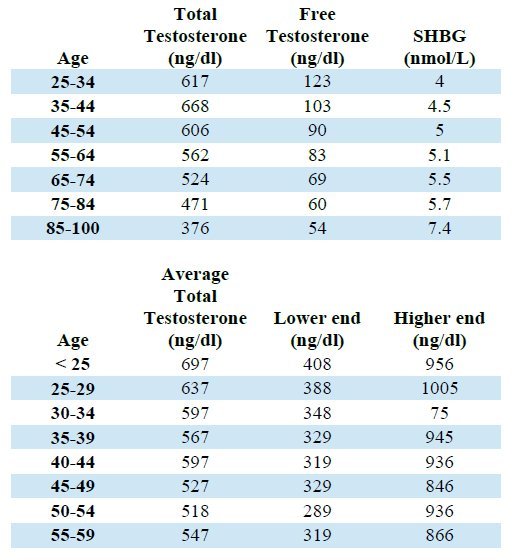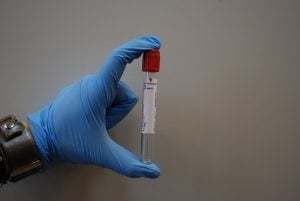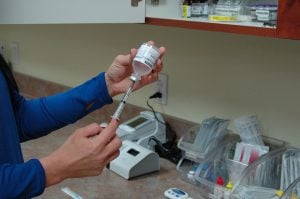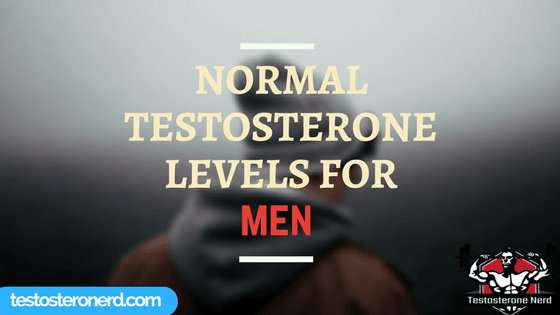As guys, keeping our primary male hormone at optimal ranges is something that we should always strive for. And one of the most mind-boggling questions that have always bothered me is – what are the normal testosterone levels for men?
The normal ranges of testosterone for us men are from 300 to 1,000 ng/dL according to the University of Rochester Medical Center (1).
As you can see, this information is based on relevant data regarding normal test results for testosterone levels in guys, so yes – it’s scientifically validated.
Now, if your testosterone levels are lower than that it may be because you have a particular condition that impedes your overall testosterone production.
And if your levels are above the normal range, then a possible cause might potentially be a tumor on your testicles.
However, the good news is that even if your levels are below the norm, things are totally reversible!
Also, I’m NEVER going to recommend the quick fix e.g. anabolic steroids.
Unless you’d like to see your balls shrink and your natural test production shutting down, completely!

What is the Normal Range for Free Testosterone Levels?
Keep in mind, however, that there’s conflicting info on what’s the exact normal level range for testosterone in men.
But as we already mentioned earlier, the ranges that I’m referring to are part of a report courtesy of the University of Rochester Medical Center.
Here’s what’s considered NORMAL when it comes to total and free T:
Total Testosterone
Unfortunately, folks… most doctors and laboratories alike, tend to throw weird and unrealistic ranges, based on past patients’ results.
But hey, what if some of the 20-year-old guys tested were mega fat and had the T levels of a little girl?
Or as I’m sure some of them were rather fit, manly and walking around with high androgen activity at say 50 years of age?
All of this leads to confusion and we DO NOT want that!
There’s amazing research done on normal T levels across a wide range of old and young men, splitting different results into age brackets:
The sheer beauty of the graph below is that it’s broken down into age categories.
You can just take a peek and immediately assess your situation – where or not your T is low in relation to your age!
The Testosterone Levels by Age Chart
Below you’ll see a neat chart based on findings by Dutch scientists that shows how age affects T levels in men.

This chart is based on data from the endocrinology chapter (named “Androgen Decline In The Aging Male” ) of a urology book (2).
You don’t need to be an expert to realize how easy it is to figure out whether you’re on the lower or higher spectrum of normal testosterone levels, by using the graph above.
That is if you’ve tested your T levels!
And this brings me to another subject – an important one!
Total Testosterone or Free Testosterone?
In an ideal world, we all should shout in a singular tone – BOTH PLEASE!
Of course, we’re back to reality now so don’t stay calm now and read on.
Free Testosterone is (you’ll never guess it) not a prisoner of testosterone, it’s the free version of it.
It floats in your bloodstream remaining unbound to SHBG.
Weirdly enough, it makes only 2% of your total testosterone.
This means only this tiny amount is biologically active and is the one responsible for anabolic-friendly actions associated with your muscles!
Total Testosterone, on the other hand, is… well, great job Mr.
Einstein – the total amount of it estimated in your bloodstream!
When looking at blood sample tests for T, most (and I mean most) of the time your results are the total chunk of this hormone.
That’s partly due to free T’s sociopathic behavior – it’s a pain in the butt to get accurate measures of.
Maybe you’re all fired up now and you absolutely want to test your manliness, but you’ve got no clue… how?

How do You Test Your Testosterone Levels?
There are 3 methods for checking how many T’s coursing through your veins:
- Saliva
- Urine
- Blood
Also, you can go out to a remote bar, full of rednecks, thugs, and convicts, first.
After that, you can proceed to call them different names, while at the same time sending your best wishes to their wives/sisters/mothers etc.
In my book, this HAS got to be the most accurate way of measuring one’s manliness (or foolishness).
Doesn’t take a rocket scientist to realize that the most solid of these three is… (don’t get for a piss in this important moment) YEP, the bloody, gore-ish stuff.
With syringes and so on, you know what I’m talking about.
Remember – Blood tests are the most accurate and reliable
Blood tests are the most reliable, accurate and useful if you’re really interested in checking your testosterone levels.
But please folks, please, I beg you – go to a laboratory, don’t try any of these fancy at-home testing kits.
Medical personnel working in labs is qualified and they know they’re sh!t so don’t make your life any harder.
Of course, if you’re afraid of sharp, thin objects then there’s no harm in trying a saliva or urine test.
Just don’t be in shock if you find out that your results are as real as Pamela Anderson’s jugs!
And remember, testosterone is at its peak during early morning hours (morning wood is morning for a reason).
From around 7 AM to 10 AM!
If you plan on going out for a test, make sure it’s in that time frame.
How to Increase Testosterone Levels Fast & Easy in 7 Steps?
Here are seven easy and 100% natural steps that’ll help you to increase your T levels quickly:
- Get plenty of quality sleep (7-8 hours at least)
- Stop eating junk food, flaxseeds and anything with soy
- Start weightlifting
- Consume more eggs, pomegranate and olive oil
- Decrease your stress levels (don’t stress yourself too much)
- Catch some sun for more vitamin D (it improves testosterone production)
- Buy a testosterone-boosting supplement (check my Testogen Review)
Now, these seven steps will most definitely increase your natural test production and the overall amount of testosterone in your body.
To put it short, it’s all about living a healthy lifestyle (eating right, exercising, sleeping well etc.) and staying away from bad habits (drinking, drugs, lack of sleep etc.).

What is the Optimal Testosterone Level?
The optimal range for testosterone levels is around 800 to 1100 ng/dL.
This optimal spectrum is based on the 300-1,000 ng/dL normal range by the URMC that we cited earlier in this article.
Anything below or above this range is considered abnormal by the scientific field, meaning you should try to stay within this ng/dL territory!
However, men who suffer from low T might need potentially need to raise their levels to around 650 ng/dL to start feeling better again.
But this is specific to each person, so don’t stress too much about numbers as you’ll instantly know when you’ve overcome the low testosterone trap.
As a general rule of thumb, trying to stay in the middle of the 300-1000 ng/dL range would probably suffice for most guys in terms of maintaining an optimal amount of T in your body.
Always Aim to Keep Your Testosterone Levels Within the Optimal Range
Listen, if your testosterone levels are a tad more than 300 ng/dl could still be considered within the norm.
But you’re better off implementing a change to your lifestyle in order to optimize those numbers.
And of course, treating low testosterone naturally is more than possible, but you’d be much better off just staying within the upper portion of the normal range.
The same can perfectly apply when you’re somewhere around the ideal middle, say the 500-600 ng/dl mark.
You might give yourself a pat on the back, but NOT so fast cowboy! Do you want to settle down for mediocrity?
For just “normal” levels of your primary male hormone?
I bet you DON’T! And I’ll help you with that my friend, no worries here.

What About Your Doctor – Do They Care About Your Natural T Production?
Your doctor probably does, or at least should.
The problem is that most of them just go with the cookie-cutter approach for dealing with low T especially.
99% of the time this approach is TRT – testosterone replacement therapy i.e. synthetic testosterone.
Let’s say that you are practically on the verge of low T, but not there yet.
I mean, imagine your results from a blood test show that you are so bloody close to being below what’s considered normal, that it’s ridiculous.
Now, as most medical personnel, the endocrinologist (or even your GP) checking you will most likely give you a pat on the back and tell you that everything’s alright, your levels are within the norm and there’s nothing to worry about.
He holds no remorse as you are INDEED within the normal range, so no worries then?
WRONG!
This is like saying that your car still has fuel while the red light for low fuel in the tank is flashing.
Yeah, in reality, you DO have fuel, the problem is… how MUCH fuel do you actually have?
The same applies to such borderline conditions, connected to typical testosterone values in us males.
You Have To Do Something About It
Unless you have like ZERO testosterone in your system, chances are you should be able to increase your natural production.
So that you may meet the criteria for normal and healthy levels of your primary male hormone.

What Happens When a Man’s Testosterone is Low?
When your testosterone levels get low, you will most likely start experiencing one or more of the most common symptoms associated with low T:
- Low energy and fatigue
- Reduced libido and sex drive
- Decreased muscle and bone mass
- Sleep disruption and difficulty sleeping
- Mood swings and general irritability
- Reduced amount of semen produced
- Increased body fat levels
But while these symptoms might be common, some men won’t necessarily experience any of them for that matter.
That’s why checking your T levels via a blood test (preferably) is always a good idea if you’re unsure whether or not you have low T.
Another potential method for diagnosing this condition can be a bone density test that your doctor could request.
How Do You Fix Low Testosterone?
The best way to fix your low T issues begins by trying the following lifestyle changes:
- Start taking a proven, quality testosterone booster (like Testogen)
- Eat the right testosterone friendly foods (e.g. coconut oil, pomegranate, bananas)
- Avoid certain testosterone lowering foods (e.g. soy, junk food, flaxseeds)
- Aim to get enough restful sleep
- Start weightlifting
As you can see, you’ve got plenty of options when it comes to taking control of your very own testosterone production!
On a side note – always do a blood test to determine whether or not you really suffer from low testosterone!
Even better, all of the methods listed above are 100% natural.
This means that yes – you can increase your natural T production without resorting to harmful substances i.e. anabolic steroids.

Is a Testosterone Level of 350 Low?
A T level below 350 ng/dL can be either low or normal, depending on your age.
For instance, this amount would be considered quite low for a 20-year-old, while being perfectly acceptable for an 80-year-old man.
But generally speaking, if you’re T levels measure 350 ng/dL then yes – you’re on the lower end of the spectrum.
Don’t forget that anything below 300 ng/dL is considered abnormal i.e. it means that your T levels are low.
Still, this doesn’t mean that you suffer from low testosterone as there are other symptoms and tests that can determine that with certainty.
Measuring total testosterone levels isn’t the only method of assessing your testosterone health.
Testing your free and bioavailable testosterone levels can be used as another way for helping to diagnose low T.
But if your T levels are indeed low, consider giving the best testosterone booster for men a try as I’ve personally used it and it does work.
Conclusion
This is where we conclude today’s topic so I really hope that you’re now more familiar with what the normal range of T levels is.
And what kind of methods are being used for measuring and what you can do to increase your own testosterone production.
Sure, having normal T levels is good… but having higher T levels while still staying within the norm is EVEN better!
Don’t count on the pharmaceutical industry-backed physicians to care too much for your manliness – above all, it’s YOUR responsibility!
With valuable information (like the one provided here at TN) and enough willpower, EVERY single man will be able to hone his level of virility!
Over to you now – have you ever done a blood test to find out how much testosterone is coursing through your veins?
And if yes – is your T on the lower end of the spectrum or are you more leaning towards the realms of high T?
Leave your answer below!
FAQs
What are normal testosterone levels for men?
Normal testosterone levels for men typically range from 300 to 1000 nanograms per deciliter (ng/dL).
However, levels can vary throughout the day and may decrease with age.
What are the symptoms of low testosterone in men?
Symptoms of low testosterone in men may include decreased sex drive, erectile dysfunction, decreased muscle mass, fatigue, mood changes, and decreased bone density.
However, these symptoms can also be caused by other factors, so it’s important to talk to a healthcare provider to determine if low testosterone is the cause.
How is low testosterone diagnosed in men?
Low testosterone is typically diagnosed through a blood test that measures the level of testosterone in the bloodstream.
However, the timing of the test and the interpretation of the results can be complex, so it’s important to talk to a healthcare provider to determine if further testing or treatment is necessary.
What are the treatment options for low testosterone in men?
Treatment options for low testosterone in men may include testosterone replacement therapy (TRT), which can be administered in several forms, including injections, gels, patches, or pellets.
Lifestyle changes, such as exercise and weight loss, may also help to increase testosterone levels.
Are there any risks associated with testosterone replacement therapy?
Yes, there are some risks associated with testosterone replacement therapy, including an increased risk of blood clots, sleep apnea, and prostate cancer.
However, these risks are relatively rare and can be managed through careful monitoring by a healthcare provider.
It’s important to discuss the potential risks and benefits of TRT with a healthcare provider before starting treatment.
What causes low testosterone levels in men?
Low testosterone levels in men can be caused by a variety of factors, including age, obesity, certain medical conditions (such as diabetes and hypothyroidism), medications (such as opioids and steroids), and injury or infection to the testicles.
Can high testosterone levels be harmful to men?
Yes, high testosterone levels can be harmful to men and may increase the risk of certain health problems, such as prostate cancer, blood clots, and sleep apnea.
However, it’s important to note that testosterone levels naturally decline with age, so a level that may be considered high in a younger man may be normal in an older man.
How can I naturally increase my testosterone levels?
There are several natural ways to increase testosterone levels, such as regular exercise (especially strength training), maintaining a healthy weight, getting enough sleep, managing stress, and eating a balanced diet that includes protein, healthy fats, and micronutrients like zinc and vitamin D.
Can testosterone replacement therapy cause infertility?
Testosterone replacement therapy (TRT) can decrease sperm production, which can lead to infertility.
However, TRT can also improve fertility in some men by increasing the quality and motility of their sperm.
If fertility is a concern, it’s important to discuss the potential impact of TRT on sperm production with a healthcare provider.
Can women have testosterone levels in the normal male range?
Yes, women can have testosterone levels in the normal male range, which typically ranges from 300 to 1000 ng/dL.
However, testosterone levels in women are generally lower than in men, and high levels can cause symptoms like facial hair growth, acne, and a deeper voice.
If a woman is experiencing these symptoms, it’s important to talk to a healthcare provider to determine the cause and appropriate treatment.
I've been fascinated by natural male hormone optimization since 2016. And ever since I've been going through boatloads of different meta-analyses and scientific data associated with increasing testosterone levels naturally. I hold a PhD degree in public health and have 10+ scientific publications on Google Scholar. Thus, in my collective work here you'll find helpful tricks, natural remedies, detailed product reviews (including stuff I've personally tried)... and more!







Thank you for this article! We’ve been trying to understand the reason for 0 sperm production and our doctors unfortunately don’t seem to be really focusing on the lab work that my husband got back. Would you say there’s any red flag in my husbands blood work results?
Total T: 819 ng/dL
Free T: 69.9 pg/mL
SHBG: 60 nmol/L
Thanks so much for the help/guidance!
Hi Haley and welcome!
I appreciate your kind words and I’m sorry to hear that your husband is having fertility issues.
I’d suggest speaking to an endocrinologist or alternatively a urologist who should be able to assess the situation and interpret those results.
Your hubby’s total T is normal and on the higher end of the spectrum. His free T is on the lower end though (69.9 pg/ml equals 7 ng/dl).
Still, better to do some sperm quality tests and consult with a specialist.
Let me know how it goes.
Cheers and God bless,
— Simon
I just got the blood test and my total is 770 and I am 64 years old. The test says abnormal. I think I would consider it great for my age. I take care of myself and have weight lifted since I 30 years old. I also do lots of cardio, eat right, and get plenty of sleep and have quite alcohol. Your thoughts??
Hey there Archie – welcome to Tnerd!
Your total T is within the normal range, although it’s leaning toward the higher end of the spectrum.
But that’s no cause for concern, you should actually be quite happy that you have more testosterone than many 20 and 30-year-olds.
As for alcohol, a glass of wine or a bottle of beer might be okay but drinking too much is bad for your hormones and overall health.
Cheers and God bless,
— Simon